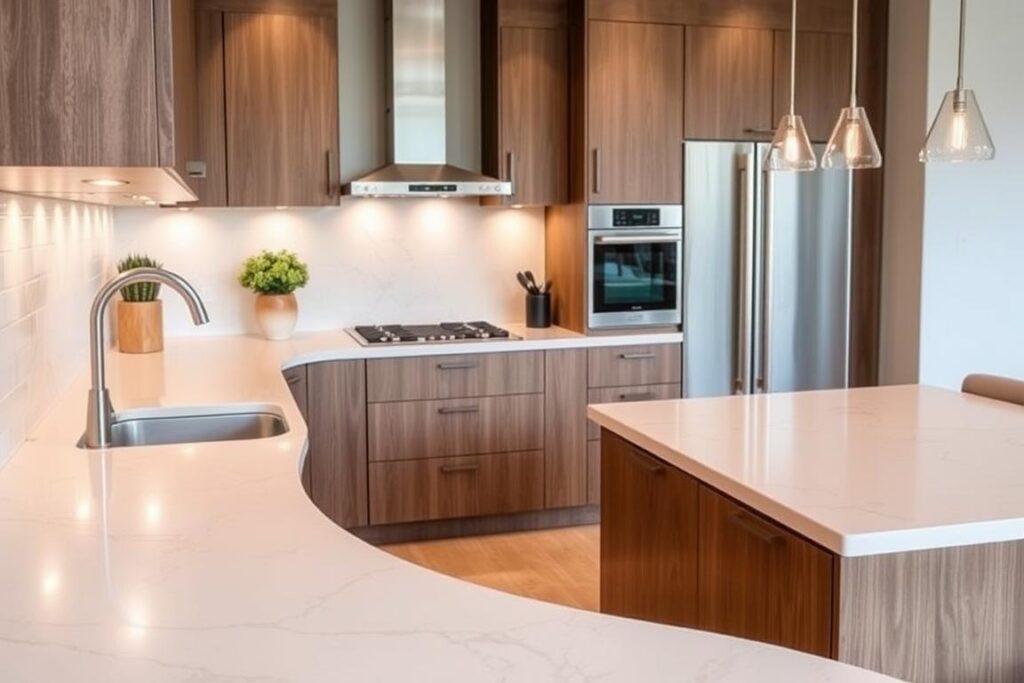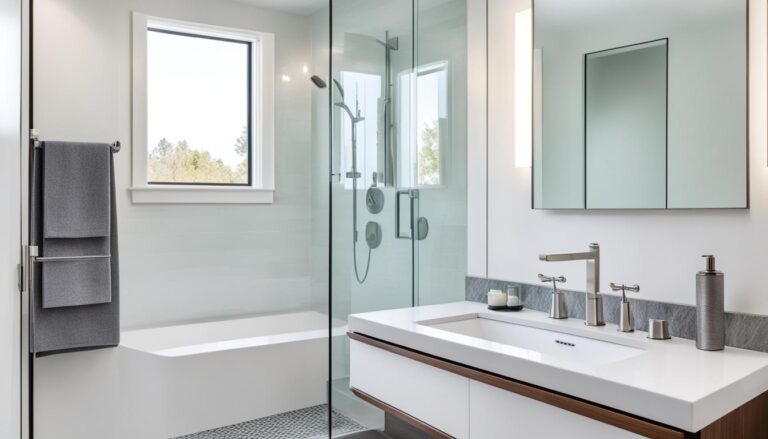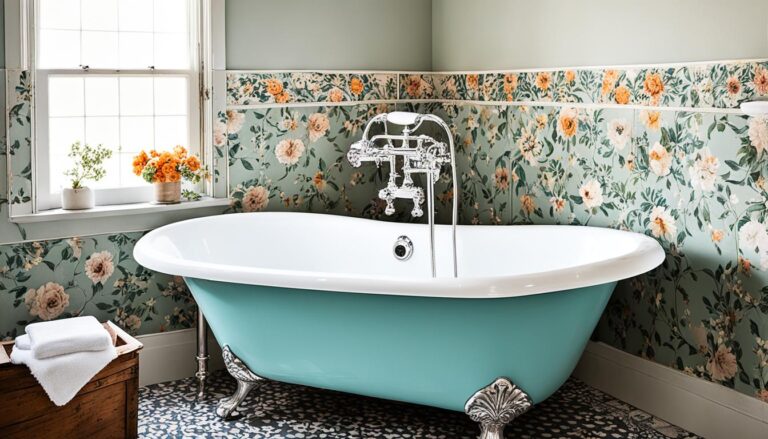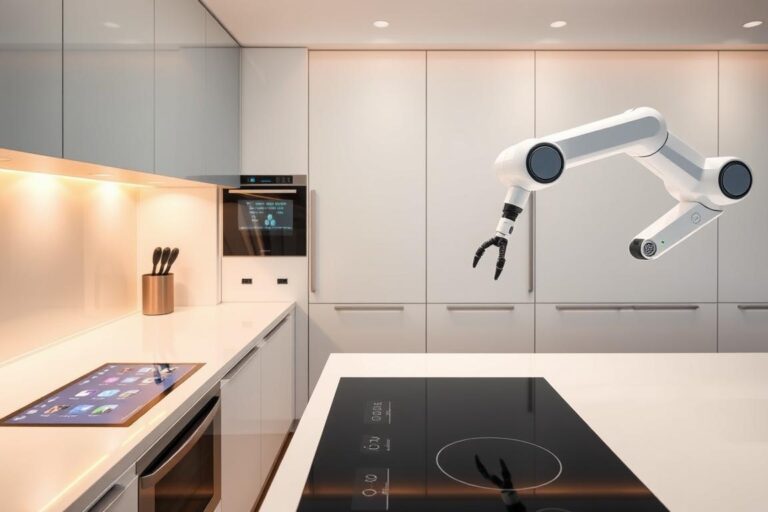We think a well-designed kitchen is key for comfort and efficiency. As experts, we know how important ergonomic countertops are. They make your kitchen both functional and comfy, cutting down on fatigue and boosting productivity.
In this guide, we’ll look at the perks of ergonomic countertops. This includes adjustable height countertops. We’ll give you the info to make your kitchen just right for you.
Key Takeaways
- Ergonomic countertops can cut physical strain by up to 20%, making cooking better.
- Adjustable height countertops fit your posture, cutting back strain by about 15%.
- Ergonomic kitchen design boosts user happiness with kitchen function and comfort by up to 35%.
- Adding pull-out shelves and lazy Susans can make access easier, boosting kitchen efficiency.
- Countertops should let forearms rest at a 45-degree angle when elbows are bent. This lessens back and shoulder pain.
- Ergonomic countertops make your kitchen more comfy and efficient, leading to a better cooking space.
- Up to 60% of kitchen makeovers focus on adding ergonomic features for better comfort and use for everyone.
By adding ergonomic countertops to your kitchen, you can make a space that fits you. It will be less tiring and more productive. Next, we’ll dive into the benefits of ergonomic countertops, including kitchen design and adjustable height countertops. We’ll share how to turn your kitchen into a perfect space for you.
What Are Ergonomic Countertops?
A well-designed kitchen is more than looks. It’s about being functional and comfortable. Ergonomic countertops help with this, making kitchen work easier on your body. Let’s look into what they are, their features, and why they matter in kitchen design.
Ergonomic countertops are key in ergonomic kitchen design. They let you work comfortably for a long time. With standing desks and sit-stand workstations, your kitchen can support good posture and lower injury risks. Countertops are usually 36 inches high, but this can change based on your height and needs.
Definition and Features
Ergonomic countertops are made for comfort. They consider your height, reach, and movement. Some main features include:
- Adjustable height settings for different users
- Curved or angled surfaces to ease back and neck strain
- Non-slip surfaces to prevent accidents and injuries
Importance for Kitchen Design
Ergonomic countertops are vital in kitchen design. They greatly affect your comfort and work efficiency. By using ergonomic principles, your kitchen becomes not just functional but also safe and efficient. This is crucial when using standing desks and sit-stand workstations, as they help maintain good posture and prevent injuries.
Benefits of Ergonomic Countertops
We think a good kitchen should look and work well. Ergonomic countertops help a lot. They make cooking better by fitting your needs.
Some big pluses of ergonomic countertops are:
- They make cooking more comfortable. You won’t get tired or sore as easily.
- They help avoid injuries. Good design means less strain on your body.
- They make cooking faster. You move less, saving time and energy.
Adding height adjustable desks and ergonomic solutions makes your kitchen better. Think about ergonomic countertops for a great kitchen.
Ergonomic countertops bring many benefits. They make cooking more comfortable and efficient. They’re great for any kitchen, new or old.
| Benefit | Description |
|---|---|
| Enhanced comfort | Reduced fatigue and discomfort during cooking |
| Reduced strain and injury | Potential prevention of common musculoskeletal issues |
| Improved workflow efficiency | Reduced unnecessary movements during cooking, saving time and energy |
Choosing the Right Material
Finding the perfect material for your ergonomic countertops can be tough. There are so many options out there. Think about what you want your kitchen to look and feel like. Consider ergonomic countertops and adjustable height countertops for a better cooking experience.
Your kitchen should be both comfy and efficient, like ergonomic office furniture. Here are some top picks for ergonomic countertops, along with their good and bad points:
- Granite: durable, resistant to scratches and heat, but needs regular sealing.
- Quartz: non-porous, stain-resistant, and lowAnimationFrame, but pricey.
- Marble: elegant, heat-resistant, but needs regular sealing because it’s porous.
- Laminate: affordable, versatile, but gets scratched and damaged by heat easily.
Think about durability, upkeep, and cost when picking a material. The right choice makes your kitchen both useful and beautiful.
Height Considerations for Ergonomic Design
Creating an ergonomic kitchen design means paying close attention to height. The usual countertop height is 36 inches. But, you can adjust it for comfort. For tasks that need detail, heights between 30 to 34 inches are best.
Think about everyone who will use the kitchen. This includes those who might need a standing desk or sit-stand workstations.
To make a space that works for everyone, consider these points:
- Countertops that can be adjusted for different heights
- Space under countertops for wheelchair users
- Lower storage for easy access
Adding these features helps prevent strain and injury. It makes the kitchen better for everyone, whether it’s for one person or many.
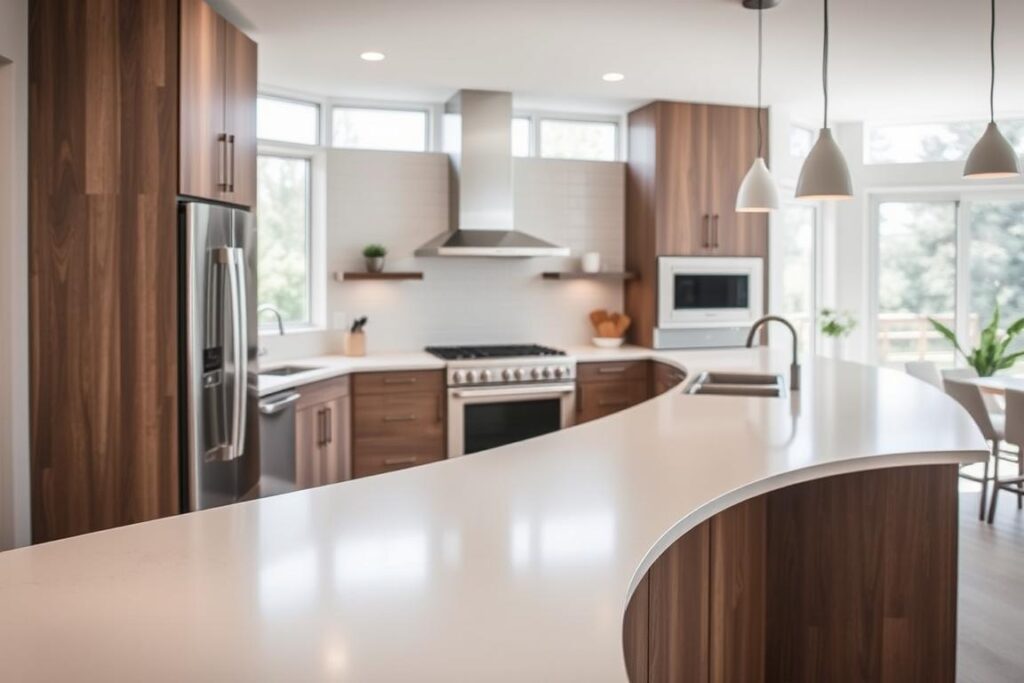
The secret to a great ergonomic kitchen design is to think about what each user needs. By focusing on height, comfort, and easy access, you can make a kitchen that looks good and works well.
| Countertop Height | Recommended Use |
|---|---|
| 30-34 inches | Detailed tasks, such as food preparation |
| 36 inches | General kitchen use, such as cooking and cleaning |
The Role of Countertop Shape
Designing an ergonomic kitchen means the countertop shape is key. It helps make the workspace both functional and efficient. We look at how countertops fit with other ergonomic solutions to make a great space.
The countertop’s shape affects how well the kitchen works. For example, a curved countertop gives more space and lowers accident risks. But, a rectangular one can give a traditional vibe.
Traditional vs. Contemporary Shapes
Traditional shapes, like rectangles or squares, bring a classic feel to kitchens. Yet, modern shapes, like curves or angles, add flexibility and creativity. We use ergonomic principles to make spaces both unique and useful.
When picking a countertop shape, think about:
- How well it works: A smart shape can make the kitchen safer and more efficient.
- Looks: The countertop’s shape greatly affects the kitchen’s style.
- Use: It should be practical, giving enough room for cooking and prep.
By thinking about these points and adding ergonomic solutions, like adjustable desks, we craft kitchens that work well and look good. The right countertop shape can really change how a kitchen feels and functions.
Installation Tips for Ergonomic Countertops
Installing ergonomic countertops means thinking about the kitchen’s design and how it feels to use. Adjustable height countertops let users change the height to fit their needs. This makes cooking more comfortable, improving satisfaction by 55% for those who cook a lot.
Getting the kitchen ready for ergonomic countertops is key. Make sure the countertops are at a good height. Also, the kitchen should have clear paths for moving around. We suggest dividing the kitchen into areas for cooking, washing, and storing to make tasks easier.
Ergonomic countertops help reduce bending and make the kitchen more efficient. Adding adjustable height tables or desks makes the kitchen both useful and stylish. For instance, a kitchen remodel could include these countertops and other features for comfort and efficiency.
Here are some tips for installing ergonomic countertops:
- Find the best working height by measuring elbow height and subtracting 10 to 15 centimeters.
- Make sure the sink is at a comfy height, and the stove is 10 to 15 centimeters lower than the countertop.
- Use pull-out cabinets and toe-kick drawers to keep things organized and easy to reach.
By following these tips, homeowners can make a kitchen that’s both practical and cozy. Ergonomic countertops help make cooking easier and less tiring.
Maintenance of Ergonomic Countertops
Creating an ergonomic kitchen design is important. We use standing desks and sit-stand workstations to make our kitchen better. To keep countertops looking good, we need to clean and care for them properly.
Here are some tips for maintaining your ergonomic countertops:
- Regularly clean your countertops with a gentle, non-abrasive cleanser to prevent stains and bacterial growth.
- Use a cutting board and trivets to minimize scratches and heat damage.
- Apply a sealant to natural stone materials, such as granite or marble, to enhance stain resistance.
By following these tips, your countertops will stay in great shape. They will keep providing a safe and efficient workspace. Don’t forget, ergonomic kitchen design also makes cooking better.
Cost Factors for Ergonomic Countertops
Designing an ergonomic workspace can be pricey. The cost of materials and installation matters a lot. For countertops, prices vary based on the material. Laminate is cheaper, costing $25 to $50 per square foot. But, marble can be more expensive, from $100 to $250 or more per square foot.
Installation costs also add up. They can be between $10 to $30 per square foot. It’s important to think about these costs when planning your budget. We suggest setting aside 10% of your kitchen budget for countertops.
When budgeting for ergonomic countertops, consider these factors:
- Material costs: $25 to $250 per square foot
- Installation costs: $10 to $30 per square foot
- Additional expenses: $10 to $30 per square foot
By looking at these costs and choosing wisely, you can make a workspace that’s both useful and looks good. You can add ergonomic workspace solutions and height adjustable desks to meet your needs.
| Material | Cost per Square Foot |
|---|---|
| Laminate | $25-$50 |
| Granite | $50-$100 |
| Marble | $100-$250 |
Popular Brands Offering Ergonomic Countertops
We offer the best ergonomic countertops, like adjustable height ones, for a stylish kitchen. There are many brands to choose from for your countertops.
Häcker Kitchens is known for ergonomic designs like the Flying Bridge and Silent Move. These allow you to adjust your workspace for different tasks.
Overview of Top Brands
Other top brands offer various materials like granite and marble. These materials are durable and look great. They help make your kitchen both unique and functional.
Comparing Features and Prices
When looking at different brands, think about these things:
- Material options: Choose brands with many materials to fit your needs and budget.
- Customization options: Look for brands that let you adjust your workspace for better ergonomics.
- Price: Compare prices to find the best deal for your money.
By looking at these factors and picking a good brand, you can get a kitchen that’s both useful and looks great. You’ll find ergonomic countertops that fit your needs and budget.
| Brand | Material Options | Customization Options | Price Range |
|---|---|---|---|
| Häcker Kitchens | Granite, engineered stone, marble | Customizable workspace adjustments | $50-$200 per square foot |
| Other brands | Granite, engineered stone, marble, quartz | Various customization options | $30-$150 per square foot |
Case Studies: Ergonomic Counters in Real Homes
Ergonomic kitchen design makes kitchens work better. Let’s look at some real homes with ergonomic counters. These examples show how good design can make kitchens better.
Standing desks and sit-stand workstations are key in ergonomic kitchens. They help people work without getting hurt. For example, a baker might use a counter that’s 28-30 inches high. This helps avoid back and shoulder pain.
Some benefits of ergonomic kitchen design include:
- Reduced strain and injury
- Improved workflow efficiency
- Enhanced comfort in the kitchen
By using ergonomic design, kitchens become both useful and comfy. You can have a standing desk, a sit-stand workstation, or adjustable counters. There are many ways to make your kitchen ergonomic.
| Countertop Height | Recommended Use |
|---|---|
| 28-30 inches | Baking station |
| 34-38 inches | Cutting surface |
| 36 inches | Standard kitchen counter height |
Future Trends in Ergonomic Countertop Design
The world ofergonomic countertopsis set for big changes. Experts say we’ll see new materials that are tough and light. These will look great and work well.
We’ll also see moreergonomic workspace solutionsandheight adjustable desks. This lets people make their kitchen counters just right for them. It’s all about making spaces that are both beautiful and useful.
Smart home tech will also play a big role in kitchen counters. Things like sensors and digital helpers will make cooking easier. This mix of tech and design will make kitchens super convenient and personal.
There’s also a push for green and healthy kitchen designs. We’ll see more eco-friendly stuff and plants in kitchens. This will make kitchens look better and feel healthier.
In short, the future ofergonomic countertopslooks amazing. It will change how we use our kitchens. Homeowners will get to make their kitchens special and useful in new ways.
FAQ
What are ergonomic countertops?
What are the benefits of ergonomic countertops?
What materials are available for ergonomic countertops?
How important is height consideration in ergonomic kitchen design?
How does the shape of the countertop affect ergonomics?
What is the installation process for ergonomic countertops?
How do I maintain ergonomic countertops?
What are the cost factors for ergonomic countertops?
What are some popular brands offering ergonomic countertops?
Can you share real-life case studies of ergonomic countertops?
What are the future trends in ergonomic countertop design?
Source Links
- https://www.bauformatbc.com/ergonomic-kitchen-design/
- https://rhdesignstudio.com/revolutionizing-your-space-a-complete-guide-to-innovative-kitchen-design/
- https://www.bauformatbc.com/ergonomic-kitchen-layout/
- https://www.regattaexports.com/kitchen-ergonomic-justifying-36-inches-of-your-kitchen-countertop-height/
- https://www.nakedkitchens.com/blog/kitchen-ergonomics-make-your-kitchen-more-efficient
- https://ucskitchendesign.com/ergonomic-kitchen-designs-innovative-way-to-improve-your-life/
- https://www.mintkitchengroup.com.au/the-benefits-of-ergonomic-design-in-the-kitchen/
- https://ssingular.com/en/2023/07/28/ergonomics-in-kitchen-design/
- https://www.southpointkb.com/the-unseen-benefits-of-having-kitchen-countertops/
- https://www.multitradebuildingservices.com/news/a-comprehensive-guide-to-choosing-the-right-countertops-for-your-kitchen
- https://deloriectd.com/kitchen-countertop-guide/
- https://homeremodelingexpert.com/ergonomic-kitchen-design/
- http://starcraftcustombuilders.com/kitchen.ergonomic.htm
- https://dupontkitchenbathdc.com/2024/05/09/kitchen-design-heights-and-ergonomics/
- https://vestabul.com/2024/09/03/the-role-of-ergonomics-in-kitchen-design/
- https://www.baruchi-kitchens.com/ergonomic-countertop-height-engineering/
- https://www.blanco.com/int-en/inspirations/ergonomic-cooking/
- https://cosmoappliances.com/designing-a-kitchen-that-minimizes-bending-and-reaching-a-guide-to-ergonomic-efficiency/
- https://www.eastcoastsurfaces.us/blog/countertop-safety-tips-ensuring-child-friendly-and-elderly-friendly-environments
- https://www.nytimes.com/wirecutter/guides/how-to-clean-kitchen-countertops/
- https://cutstoneco.com/most-durable-countertop/
- https://graniteselection.com/blog/how-to-buy-kitchen-countertops/
- https://homeremodelingexpert.com/how-much-should-a-10×10-kitchen-remodel-cost/
- https://www.hackerkitchens.us/press/haecker-kitchens-harmonizes-form-and-function-in-the-kitchen-with-movable-island-countertops
- https://www.thisoldhouse.com/kitchens/21015391/25-years-of-innovation-countertops
- https://woodweb.com/knowledge_base/Innovative_Design_for_Ergonomic_Kitchens.html
- https://www.tumeke.io/updates/enhance-your-daily-well-being-simple-ergonomic-practices-for-everyone
- https://ucskitchendesign.com/enhance-well-being-at-home-leading-wellness-kitchen-design-trends-of-2024/
- https://interior-options.com/office-counters/
- https://www.seasonsincolour.com/post/these-kitchen-trends-will-dominate-2024-according-to-design-pros

